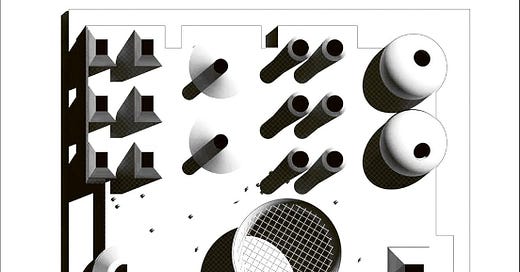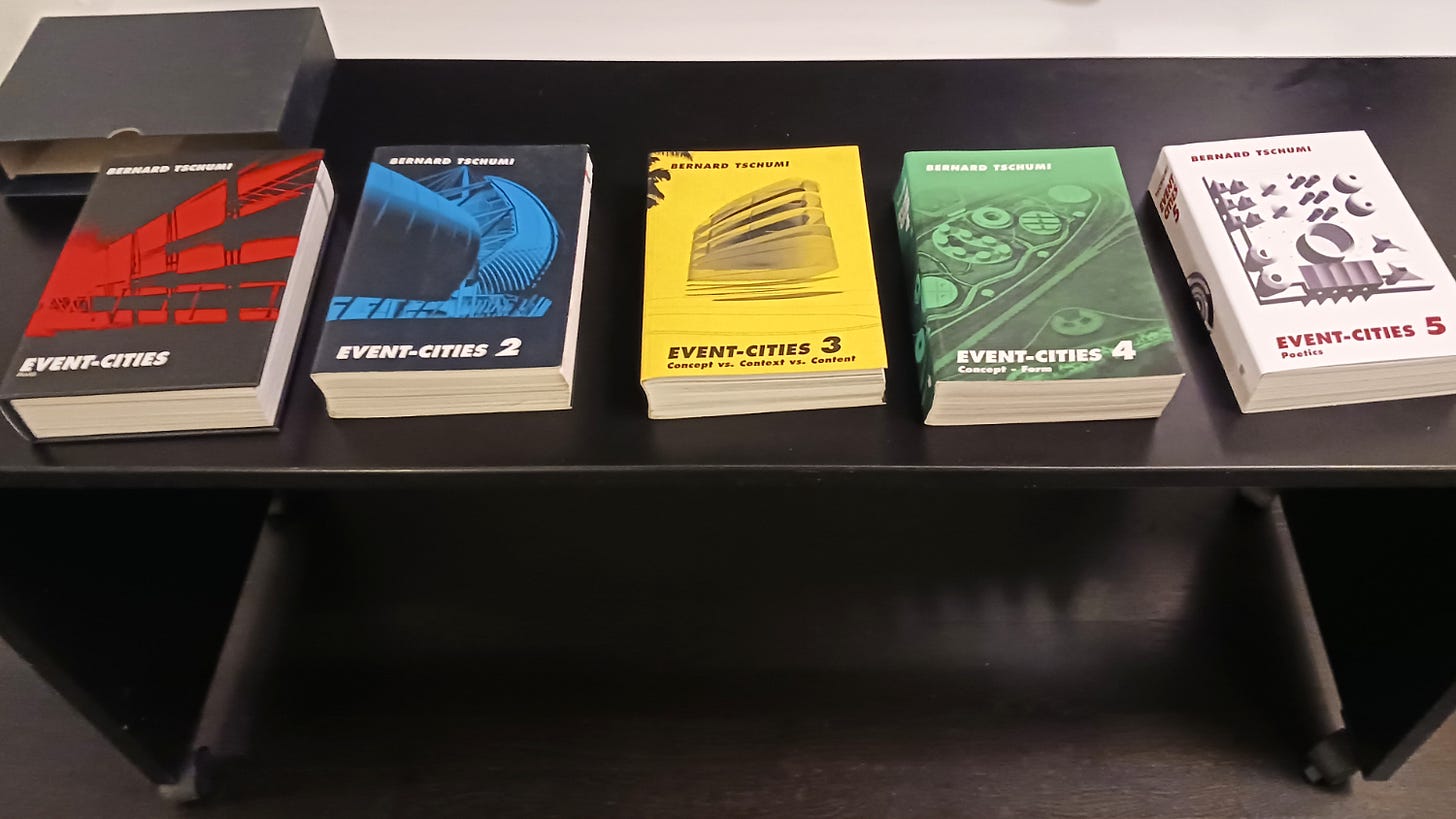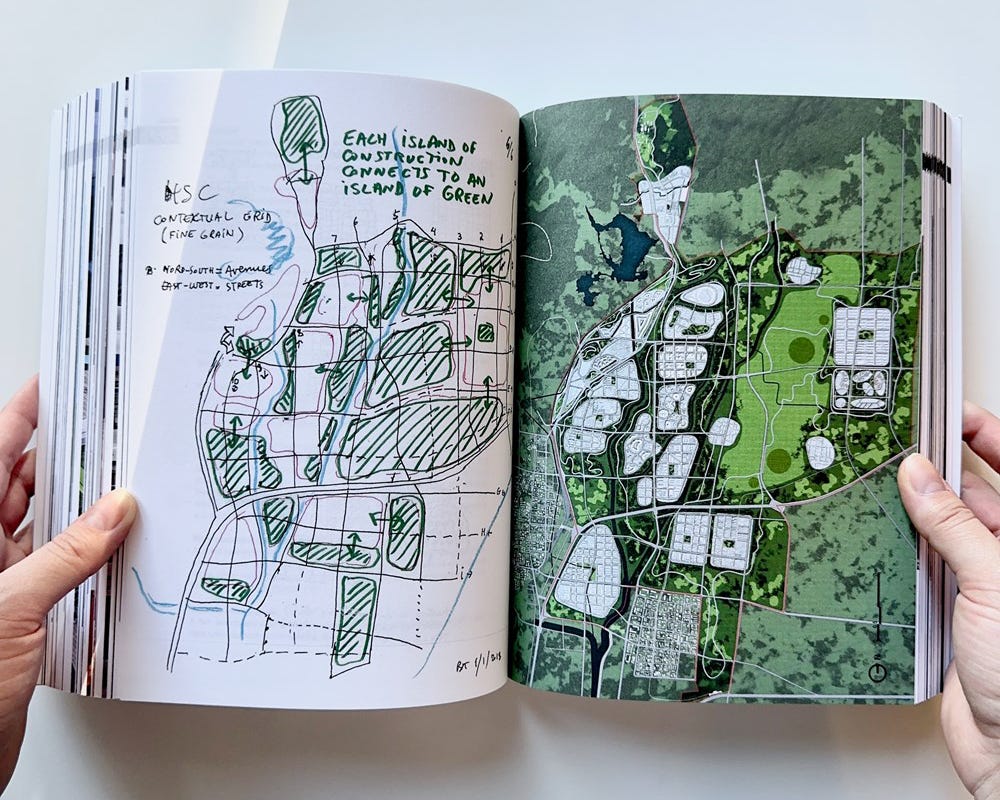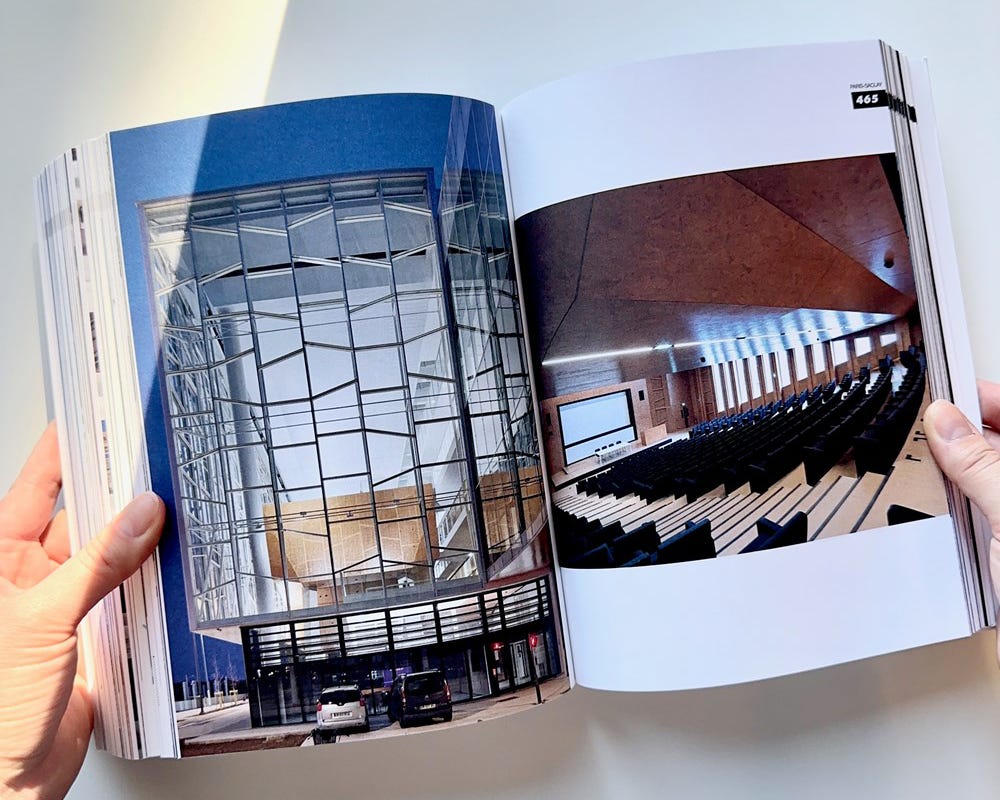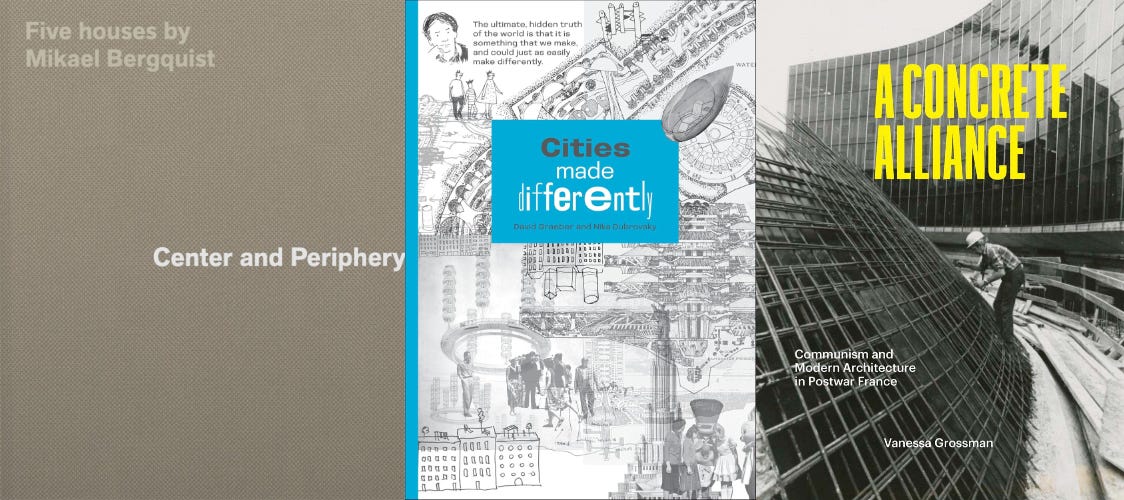This newsletter for the week of November 18 looks at Event-Cities 5, the fifth and final installment in the series of monographs by Bernard Tschumi. More books by/about Tschumi are in the archive section at the bottom of the newsletter, with the usual new releases and book headlines in between. Happy reading!
Book of the Week:
Event-Cities 5: Poetics by Bernard Tschumi (Buy from The MIT Press / from Amazon / from Bookshop)
All things must come to an end. Last week’s release of Event-Cities 5: Poetics sees the conclusion of the five-volume monograph series produced by Bernard Tschumi Architects and the MIT Press over a span of thirty years. Though not numbered, the first Event-Cities was published in 1994, when Tschumi turned fifty, Thresholds/Bernard Tschumi: Architecture and Event was on display at MoMA, and MIT Press also released Architecture and Disjunction, a collection of thirteen essays written by Tschumi between 1975 and 1991. Tschumi recalls in the introduction to Poetics how Roger Conover, then executive editor for art and architecture at MIT Press, was not interested in Event-Cities at first, since “MIT Press publishes books of words, not drawings.” But given the impending publication of Architecture and Disjunction, Conover thought the monograph could work as a “project discourse” — and with that term the 640-page “thick” book became the first of five such discourses exploring, in Tschumi’s words, “questions raised by architecture” and “the irresolute questions that accompany nearly every aspect of the design process.”
One of the most distinctive formal qualities of the first Event-Cities is the “intentional use of rough, photocopy-quality documents, avoiding the lush color of photographs and computer-generated images” that were de rigueur ca. 1994. That aesthetic extended to Event-Cities 2, from which this quote was taken, but the last three volumes veered away from the photocopy quality and adopted four-color photos and renderings. Nevertheless, everything else — the 7-by-9-inch page size, matte paper selection, 640 pages each, and page design — has remained the same across all five books, which means the biggest difference from volume to volume is the projects on display. While people may prize Event-Cities 2 (see bottom of this newsletter) for its inclusion of Parc de la Villette, the breakout project he won via a competition in 1983 and which wrapped up construction in 1998, the same can’t necessarily be said about Poetics, which features thirty projects in various states of realization spanning the last fifteen years, but few as recognizable or widely known as Parc de la Villette.
For me, flipping through Event-Cities 5 was akin to (re)discovery — learning more about projects I had some familiarity with but, more so, learning about projects for the first time. Following a prologue that shows some temporary, site-specific follies he designed and/or built in the late 1970s and early 1980s, the first of the book’s seven chapters presents five buildings with shared geometries: circles. It so happens that I was familiar with two of the projects in the “Circular Autonomy & Dialogue” chapter, having featured the Alésia Interpretive Center (2012) on my blog and the Carnal Hall at Le Rosey (2014) on World-Architects. Most curious is that both of these projects have circular “twins”: the Alésia Museum, not yet built, is located one kilometer from the Interpretive Center, and the Center for Science and Entrepreneurship is under construction next to Carnal Hall. These and other projects in this and other chapters find Tschumi exploring circular geometries in terms of space, function, and tectonics.
While more than sixty pages in the middle of Poetics (much more than any project in the book) are devoted to the Binhai Science Museum (2019), a massive building in Tianjin, China, with a spiral-ramped cone that makes Frank Lloyd Wright’s Guggenheim seem quaint, I was surprised — and pleased — to see two tiny projects in the penultimate chapter, in which Tschumi revisited two of the red folies punctuating the landscape at Parc de la Villette. The cafe in Folie P7 was expanded and enclosed in 2011, and the HyperTent was added to the underside of Folie L4 a decade later. Their inclusion near the end of the book (the last chapter is devoted to a handful of exhibitions) gives Poetics a nice circularity, given the follies in the prologue, as well as with the five-book series as a whole; even though Parc de la Villette is not in the first volume, I have no doubt that that famous project pushed people to buy Event-Cities upon its release. Who knows, the inclusion of the renovated folies, alongside Tschumi’s proposal to extend his earlier Le Fresnoy (1997) and the extension of the Vacheron Constantin Headquarters carried out ten years after it was first built, just might push people to buy Event-Cities 5.
Books Released This Week:
(In the United States, a curated list)
Center and Periphery: Five Houses by Mikael Bergquist (Buy from University of Chicago Press [US distributor for Park Books] / from Amazon / from Bookshop) — “The book collects five vacation homes in Sweden designed by Stockholm-based architect Mikael Bergquist. Realized over more than two decades, they are all located in the Swedish countryside and rooted in the Nordic tradition of timber construction and the simplicity and economy of Sweden’s historic farm buildings.”
Cities Made Differently by David Graeber and Nika Dubrovsky (Buy from The MIT Press / from Amazon / from Bookshop) — “What makes a city a city? Who says? Drafted over decades out of a dialogue between artist and author Nika Dubrovsky, the late anthropologist David Graeber, and Nika's then four-year-old son, this delightful and provocative book […] opens a space for invention and collaboration.”
A Concrete Alliance: Communism and Modern Architecture in Postwar France by Vanessa Grossman (Buy from Yale University Press / from Amazon / from Bookshop) — “Drawing political theory and architectural history into conversation, Vanessa Grossman probes the shifting but enduring alliance between modern architecture and the French Communist Party (PCF) in the aftermath of the political crisis of 1958…”
The Making of Modern Los Angeles: A Chronicle by Nick Patsaouras (The Boy from Athens) with Jim Birakos (Buy from ORO Editions / from Amazon / from Bookshop) — “An absorbing, insightful account of the evolution of Los Angeles over a fifty-year period: In his no-nonsense, straightforward writing style, Nick Patsaouras takes readers behind the scenes, where colossal egos clashed, where politics prevailed over principles, and where the art of compromise flourished.”
Margin and Text: Amplifying Diverse Voices in Architecture edited by Betsy West, Kelly Carlson Reddig and Jose L.S. Gamez (Buy from PA Press / from Amazon / from Bookshop) — “A collection of essays, interviews, and personal stories, as well as historical and current writings and lectures, contributed by BIPOC and female practitioners and educators in architecture.”
Twentyfive x Herzog & de Meuron by Stanislaus von Moos and Arthur Rüegg (Buy from Artbook/DAP [US distributor for Steidl] / from Amazon / from Bookshop) — “The complete works of Pritzker Prize–winning Swiss architects Herzog & de Meuron comprise around 600 buildings in nearly 40 countries. This book is a personal selection by art historian Stanislaus von Moos and architect Arthur Rüegg of 25 of the most important projects from throughout Herzog & de Meuron’s career.”
Full disclosure: As an Amazon Associate, AbeBooks Affiliate, and Bookshop.org Affiliate, I earn commissions from qualifying purchases made via any relevant links above and below.
Book News:
Otaku USA Magazine reveals a couple books being released by Viz Books next month, including Studio Ghibli: Architecture in Animation, an extension of the exhibition of the same name. Naturally, it includes “gorgeous art” from Hayao Miyazaki's movies, though I'm most excited about the interview between the famed director and architect Terunobu Fujimori. (For more on Fujimori see my review of the eponymous book edited by Michael Buhrs and Hannes Rössler, published by Hatje Cantz in 2012.)
The Bookseller reports that Eyal Weizman, director of Forensic Architecture, is working on an "urgent and devastating" book on Gaza, Ungrounding, set to be published by Fern Press, an imprint of Vintage, next year. (It sounds like an extension of his amazing 2007 book Hollow Land: Israel’s Architecture of Occupation, which was just republished in a new edition.)
Publishers Weekly reports that Keith Fox will step down from his position as CEO of Phaidon Press at the end of the year. Even if, like me, you aren’t familiar with Fox by name, you’ve probably seen some of the architecture titles published by Phaidon during his ten-year tenure, when he also oversaw its acquisition of The Monacelli Press, in 2020.
Domus highlights eleven bookstores and libraries that are transforming China’s countryside, “bringing local communities together around books and attracting tourists from the cities.”
From the Archives:
If literary real estate (number of pages) in a monograph is a signal of a project’s importance in an architect’s oeuvre, the Binhai Science Museum, at 64 pages, is the most important building in Event-Cities 5, this week’s Book of the Week. If we jump back to Event-Cities 2, which has far fewer projects than the final title in the series, the 182 pages given to Park de la Villette make it by far the most important project for Bernard Tschumi back in 2000. This is accentuated by the project basically being given its own chapter, “Space, Event, Movement,” and the insertion of around twenty red-on-white duotone pages among the other black-and-white photocopy-quality pages. Anyone familiar with Tschumi will not be surprised by the extensive documentation of Parc de la Villette in Event-Cities 2 (other notable projects that make this volume worthwhile include the Lerner Hall Student Center at Columbia University, where Tschumi was dean at the time, the studio’s 1997 proposal for the MoMA expansion, and the Rouen Concert Hall pictured on the cover), but this book did not have the final say on the project, as witnessed by two books featured on my blog in 2014:
In December 2014, as part of the “So You Want to Learn About” series on A Daily Dose of Architecture, I posted “So You Want to Learn About: Bernard Tschumi,” which rounded up the nine books by/about Tschumi that were in my library at the time. They were a mix of theory, exhibitions, monographs, and case studies — two of the last focusing on Parc de la Villette (#5 and #8). Here is the numbered list corresponding to the illustration above, though visit my blog to read my comments on each book (title links point to longer reviews by me, where applicable):
The Manhattan Transcripts: Theoretical Projects, St. Martin’s Press / Academy Editions, 1995
Architecture and Disjunction, MIT Press, 1996
Questions of Space, Architectural Association Publications, 1990
Index Architecture, MIT Press, 2003
SuperCrit #4: Parc de la Villette, Routledge, 2012
Architecture Concepts: Red Is Not a Color, Rizzoli, 2012
Notations: Diagrams and Sequences, Artifice Books on Architecture, 2014
Tschumi Parc de la Villette, Artifice Books on Architecture, 2014
Bernard Tschumi, Architecture: concept & notation, Centre Pompidou, 2014
Thank you for subscribing to A Weekly Dose of Architecture Books. If you have any comments or questions, or if you have your own book that you want to see in this newsletter, please respond to this email, or comment below if you’re reading this online. All content is freely available, but paid subscriptions that enable this newsletter to continue are welcome — thank you!
— John Hill

